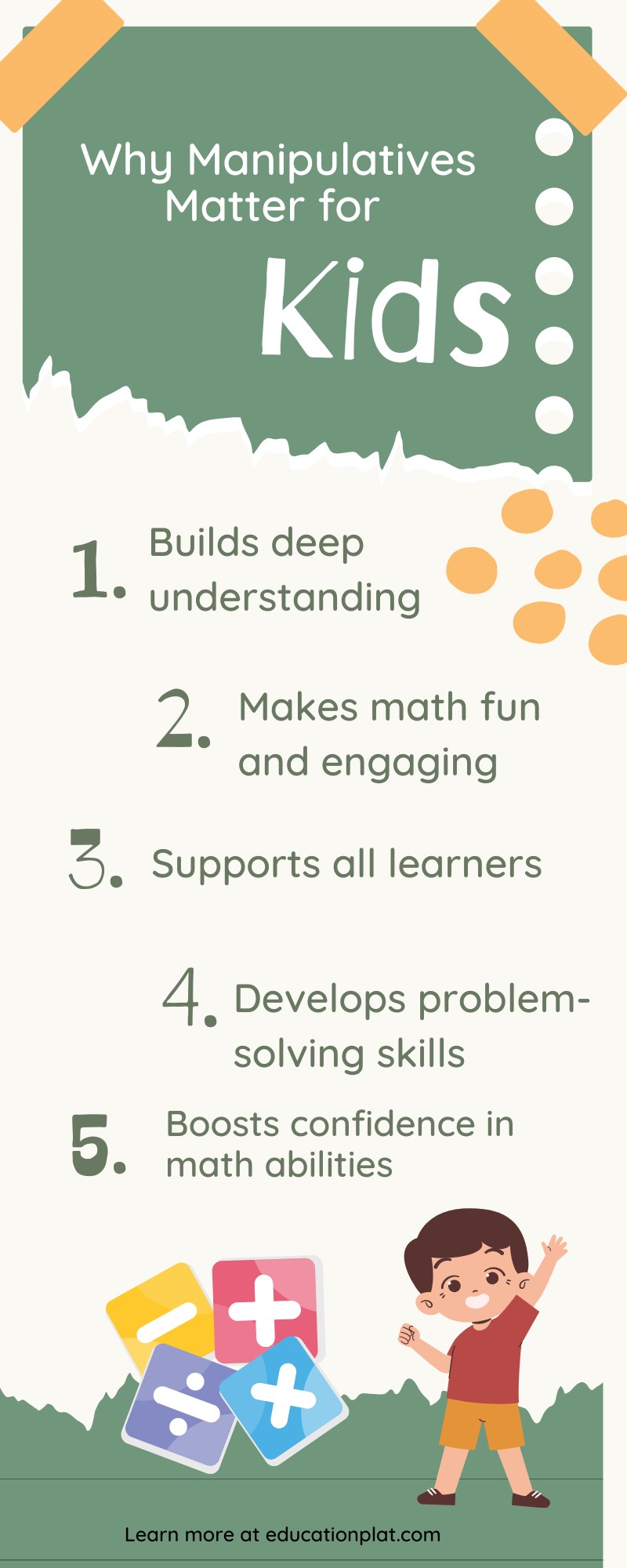Does your child struggle with abstract math concepts? Do worksheets and rote memorization lead to frustration? It’s time to transform math learning! Hands-on math manipulatives turn complex ideas into tangible experiences, making math exciting and accessible for kids of all ages. Let’s dive into the world of manipulatives and discover how they empower young learners.
What Are Math Manipulatives?
- Definition: Math manipulatives are physical objects designed to help children explore mathematical concepts in a hands-on, interactive way. They range from simple household items to specialized educational tools.
- The Power of the Physical: Manipulatives bridge the gap between abstract math symbols and real-world understanding. By seeing, touching, and manipulating objects, children build a concrete foundation for math knowledge.

Stats:
Research indicates that consistent use of math manipulatives can significantly boost math achievement, problem-solving skills, and positive attitudes towards math.
How Manipulatives Transform Math Learning
Let’s delve into specific ways manipulatives enhance the learning of core math concepts:
Number Sense and Operations
- Counting and Quantity: Counters, blocks, or even small toys help kids visualize numbers, understand one-to-one correspondence, and develop addition and subtraction skills.
- Place Value: Base-ten blocks make abstract concepts like tens and hundreds concrete, allowing children to physically manipulate and understand larger numbers.
- Multiplication and Division: Arrays, counters, or fraction tiles can be used to model multiplication as groups of objects or division as sharing.
Fractions
- Understanding Parts of a Whole: Fraction circles, bars, or pattern blocks let kids explore how different pieces fit together to form a whole, making fractions less abstract.
- Comparing and Ordering: Manipulatives allow for direct comparison of fraction sizes, helping children grasp concepts like greater than, less than, and equivalent fractions.
- Fraction Operations: Children can use manipulatives to model and solve addition, subtraction, multiplication, and division problems involving fractions.
Geometry
- Building Spatial Reasoning: Manipulatives like pattern blocks, geoboards, and tangrams encourage children to explore shapes, sizes, angles, and spatial relationships.
- Hands-On Exploration: Through building and creating with manipulatives, kids develop an intuitive understanding of geometric concepts. They can experiment with symmetry, tessellations, and rotations in a fun and interactive way.
- Classification and Sorting: Using manipulatives with different shapes and sizes allows children to practice sorting and classifying objects based on their attributes. This strengthens critical thinking skills and early algebra foundations.
Measurement
- Developing Measurement Sense: Hands-on experiences with manipulatives are crucial for building an understanding of measurement concepts like length, weight, capacity, and area.
- Non-Standard Units: Before introducing rulers and measuring cups, children can explore measurement using everyday objects like blocks, linking cubes, or even their own handspans. This helps them grasp the concept of relative size and estimation.
- Standardized Measurement: Once comfortable with non-standard units, manipulatives can be used alongside rulers, measuring cups, and scales to introduce standardized measurement tools.
Benefits for Learners of All Ages
While manipulatives are particularly beneficial for young children, their advantages extend far beyond the early years:
- Building Confidence: Hands-on experiences foster a sense of accomplishment and build confidence in math abilities.
- Problem-Solving Skills: Manipulatives encourage critical thinking and problem-solving as children experiment, explore, and make connections between math concepts.
- Deeper Understanding: The ability to visualize and manipulate objects helps learners of all ages develop a deeper understanding of abstract math concepts.
How to Get Started with Manipulatives at Home
Ready to bring the power of manipulatives into your home learning environment? Here are some tips:
Match Manipulatives to Age and Skill Level:
- Early Learners (Ages 3-6): Focus on simple manipulatives like counting bears, blocks, and colorful pattern blocks.
- Elementary School (Ages 6-11): Introduce manipulatives like base-ten blocks, fraction circles, geoboards, and tangrams.
- Middle School (Ages 11-14): Utilize manipulatives alongside protractors, compasses, and algebra tiles for exploring advanced geometry and algebraic concepts.
Playful Learning: Integrate manipulatives into game nights, create math challenges, or encourage open-ended exploration. The key is to make math fun and engaging.
Connect to Real-World Applications: Help children see the practical applications of math concepts by using manipulatives for tasks like measuring ingredients while cooking or planning furniture arrangements.
FAQs
Wrapping Up
Hands-on learning with manipulatives has the power to transform your child’s relationship with math. As you consider “why manipulatives matter for kids,” remember these key benefits. First, manipulatives build a strong foundation for future learning by helping children grasp the “why” behind math concepts, going beyond simple memorization. Secondly, manipulatives turn math into a hands-on, playful experience, sparking curiosity, fostering a love of learning, and making math enjoyable. Finally, manipulatives are valuable for learners of all levels, whether your child is a math whiz or needs a little extra support. They offer a powerful way to visualize concepts and build confidence.
